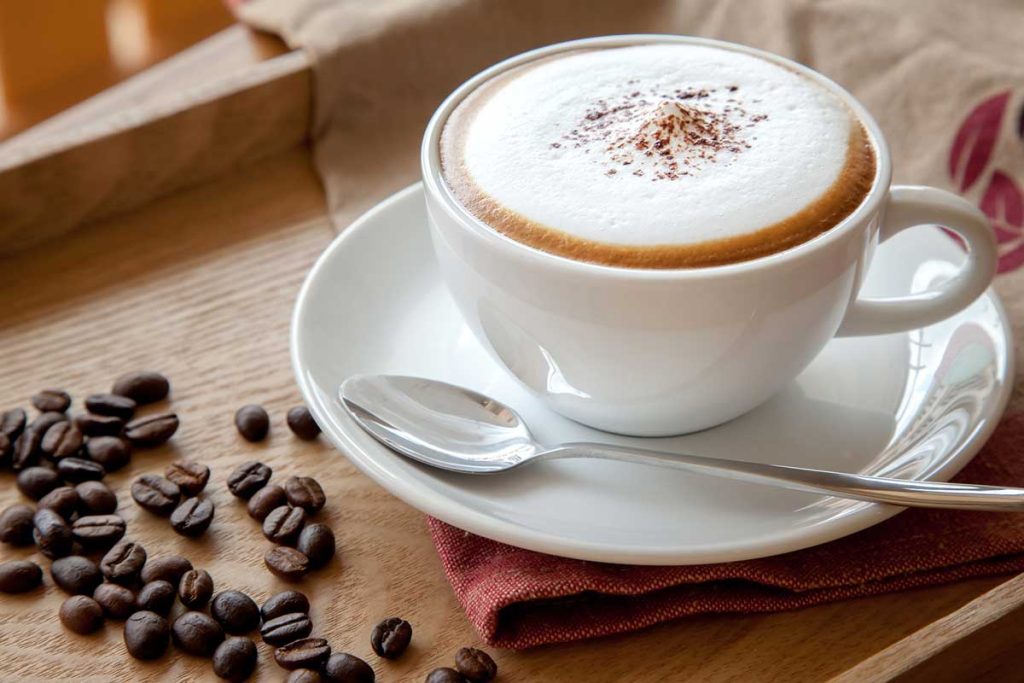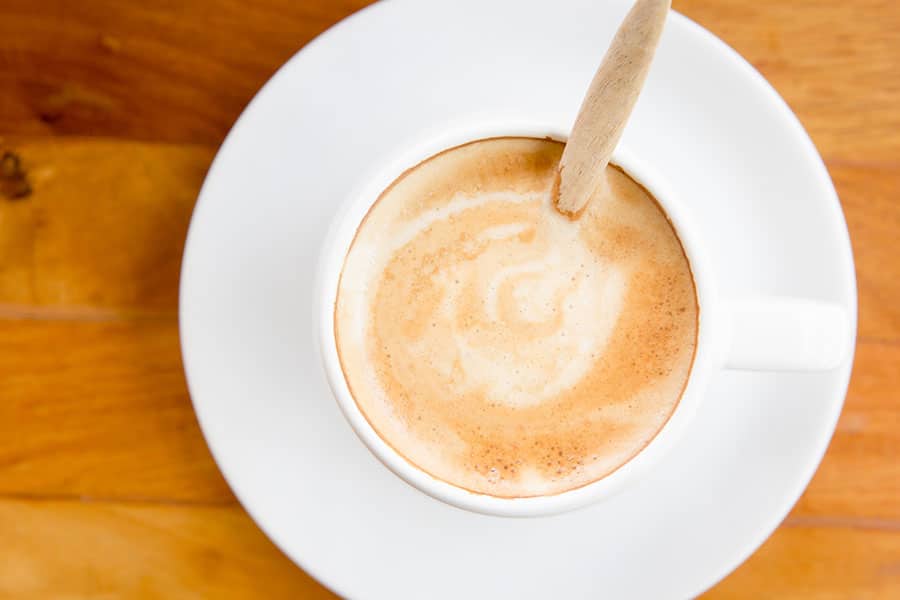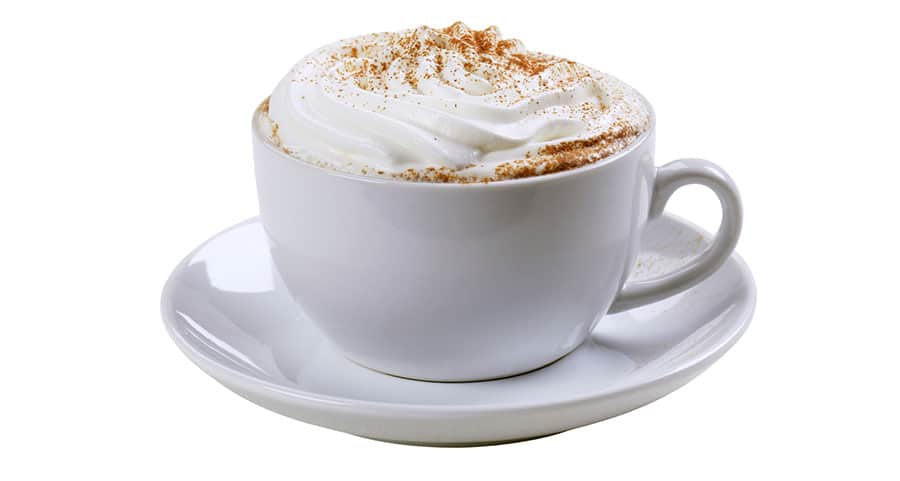What Is a Cappuccino? Deep Diving into a Classic

Even if you’re a card-carrying member of the global coffee lovers club, let me ask you: What is a cappuccino? Do you really know?
No matter where in the world you glance at a coffee menu, a hot, steamy cappuccino is always there. Essentially, this espresso-based beverage is well known for its thick milky foam layer. While it might sound simple enough, it can often be misunderstood.
As one of my favorite specialty coffee drinks, I’ve decided to give you the low-down on this popular drink. I’ll also share a very simple way to make a frothy cappuccino at home, which will keep you out of the long lines at your favorite coffee shop.
Keep reading as I highlight the ins and outs of what may become your next go-to coffee drink. Let’s start with the basics.
What Is in a Cappuccino?
Essentially, cappuccinos are made with one rule in mind: one-third espresso, one-third steamed milk, and one-third frothed milk. You’ll easily recognize it by its foamy, airy, frothed milk topping. It’s important to note that cappuccinos have a much stronger coffee flavor than other milk-based coffee drinks.
Cappuccino Origins
While many people still dispute the origins of cappuccino, the truth is believed to be that it originated in Italy in the 1900s. Coffee makers at the time claimed that the lighter brown of the drink after adding milk to the coffee reminded them of the robes worn by early Capuchin friars. Eventually, calling the drink a Kapuziner evolved into the now-famous “cappuccino.”
How Does Cappuccino Taste?
While each coffee enthusiast experiences a particular caffeinated drink differently, there can be no denying the bold flavor of a well-made cappuccino. You can expect a robust flavor and creamy texture, and since cappuccinos are made with a dark roast coffee, you’ll experience a flavor profile of toasted nuts and dark chocolate.
There’s some sweetness from the lactose sugar naturally found in the milk which can be enhanced by adding additional sugar. If you want to step away from the traditional cappuccino, you can also add flavored syrups such as caramel or vanilla.
How to Make a Cappuccino with an Espresso Machine
There were days when you could only get your favorite specialty coffee drink at your local coffee shop. Fortunately, the popularity of home espresso machines and other coffee makers has made it incredibly easy for coffee drinkers to make their favorite drinks at home.

More good news: Making a cappuccino is not as complex as you might think! My step-by-step guide will allow you to easily make a cappuccino anytime you fancy a cup.
Check out our more detailed guide on making cappuccino with your espresso machine.
Step 1: Gather Your Equipment
You’ll need the following pieces of equipment to make your first delicious cappuccino:
- Espresso machine
- Conical burr grinder
- Steam wand or milk frother
- Milk pitcher
- Large spoon
- Your favorite coffee mug
Step 2: Ingredients You’ll Need
It’s worth mentioning that if you want a vegetarian or gluten-free cappuccino, you’ll need to opt for a non-dairy option such as oat milk. Here’s a run down of the ingredients you’ll need to get started:
- About 18g (2 espresso shots) of dark roast espresso coffee beans
- 4 oz (½ cup) of whole or non-dairy milk
Optional
If you want to add extra flavor to the traditional cappuccino, consider the following:
- Chocolate, caramel, or vanilla syrup
- Chocolate sprinkles
- Spices such as cinnamon, nutmeg, or ginger
Step 3: Brewing Process
Once you have your equipment and ingredients ready, it’s time to start brewing.
- Grind your dark roast espresso beans and place them into your coffee machine
- Pull a double shot of espresso (the process of making an espresso shot is referred to as “pulling”)
- Add your flavoring syrups, if you’re using any
- Use your steam wand or milk frother to steam the milk until it’s foamy
- Layer the steamed milk over the espresso in your cup
- Scoop an equal portion of milk froth on top of the steamed milk
- Add chocolate powder or sprinkles on top of the foam, if desired
How to Make a Cappuccino without an Espresso Machine?
If you don’t own an espresso machine, you could be wondering if there’s a way for you to enjoy a delicious cappuccino. The reality is that a barista-quality cappuccino does require an espresso machine; however, a French press or a drip coffee maker will provide you with a quality that’s still pretty tasty.
The trick comes when you need to prepare the milk. Let’s have a look at the best way to do that.
Step 1: Prepare Strong Coffee
Prepare your coffee as you normally do but make it extra strong. If you have one of those automatic coffee machines, choose a “shot” and/or “strong” option. If you’re using a drip or French press, just use a 1:2 ratio of coffee to water, or something approaching that. This means using 2 grams of water for every gram of coffee. A 32 to 36 gram shot will requrie 16 to 18 grams of grounds.
Be sure to use the right dark roast beans ground to the appropriate grind size for your brewing method.
Step 2: Preparing the Milk
The steamed milk from an espresso machine’s steam wand would be perfect, but thankfully, there is an alternative.
- Use whole milk and heat it to 140-155°F on your stovetop.
- You can opt for the microwave as well, bearing in mind that it will take a few seconds.
- If you have a handheld frothing tool, froth the milk. Alternatively, you can use a whisk or blender to froth your milk.
- If you don’t have any of these, you can simply shake it very thoroughly in a mason jar with a tight, secure lid.
Step 3: Create the Cappuccino
Once you’ve found the best method to make your milk foam, it’s time to create your cappuccino.
- Pour the coffee from your French press into your mug
- Gently add an equal amount of steamed milk
- Spoon the same amount of fresh frothy milk onto the steamed milk
- You can decorate with cocoa powder, shaved chocolate, or even chocolate sprinkles for a barista-type finish
- Enjoy your easy homemade cappuccino while it’s still hot
Pro tip: Be sure to froth the milk exactly when you need it. Leaving it for too long will decrease the fluffiness of the foam.
Health Benefits of Drinking Cappuccino
When I developed a love for cappuccinos, I used to drink quite a few cups a day. Someone once asked if this was such a great idea. I must admit, up until that point I hadn’t given any potential ill effects a second thought.

Imagine my delight when I learned that there are actually several health benefits to drinking cappuccinos! Some of the major health benefits are listed below.
Antioxidants
Since caffeine contains a host of healthy antioxidants, a delicious cappuccino will not only wake you up in the morning but will also give you a great energy boost. It might be a good idea to not drink such a caffeine-filled drink late in the evening, though, if you plan on getting any sleep!
Reduces Risk of Heart Disease
For people who’ve done the research, it’s no secret that caffeine can reduce the risk of developing cardiovascular-related conditions. It can also minimize the chances of having a stroke.
Added Vitamins and Minerals
Since a properly-made cappuccino requires whole milk, a few cups a day will provide you with the nutrients found in whole milk as well. Milk is also a great source of protein and calcium, which in turn is excellent for bone health.
Fewer Calories Than Some Other Coffee Drinks
If you’re content with that slightly sweet flavor provided by the milk, you’ll eliminate the need for additional sugar. Keeping your cappuccino traditional (without added syrups and sugars) will be a much healthier choice than a latte or a frappuccino that might require added syrup.
Reduces Bad Cholesterol
With so much LDL cholesterol, the “bad” cholesterol, in our daily diets, wouldn’t it be great to reduce some of it with the drinks we consume? Caffeine has been known to increase the body’s capacity to process and reduce bad cholesterol!
FAQs
In addition to the questions I’ve already covered, there are a few other common ones that folks new to the coffee experience often ask.
Does cappuccino have caffeine?
A typical cappuccino contains about 80mg of caffeine. A 12-ounce cup of coffee has an average of 300mg of caffeine, while a 12oz cappuccino is usually made from two espresso shots and will boast a caffeine content of 160mg.
Do cappuccinos contain the most caffeine?
Cappuccinos don’t have the highest caffeine content, though. In fact, lattes are also made using a full shot of espresso, which makes them approximately equal in terms of caffeine. A medium-sized latte and cappuccino (16oz or 475ml) both contain about 173 mg of caffeine which equates to a ratio of 1:2.
How do you get cappuccino foam extra foamy?
One of the characteristics that makes cappuccino so recognizable is its foamy top. Steaming your milk into a froth is one thing, but coffee lovers making cappuccinos at home for the first time often complain that their foam isn’t as foamy as they’ve had in a coffee shop.
Here’s the first trick. Always use whole milk to create that velvety smooth foam mountain. Skim milk is lighter which means it will dissolve quicker.
The second trick is to give the milk jug or frother one final spin before pouring the foam on top. Always pour slowly from a low height to the cup and give the jug a slight jiggle to create an even foam base.
When the foam begins to form in the cup, raise the jug slightly higher and pour the rest of the foamy milk. If you’re going to add sprinkles, don’t overdo it as they’ll add weight to your foam, lessening the airy effect you want to create.
What is the difference between a cappuccino and a macchiato?
If you’re new to the coffee drinking experience you might be wondering what all the fuss is about. After all, these specialty drinks are all made with coffee, water, and sometimes milk and sugar. While this is true to a certain point, there are some differences.
While both cappuccinos and macchiatos are made from espresso and milk, the essential difference is based on proportions. As you’ll know by now, a cappuccino is made by using equal parts of espresso, steamed milk, and milk froth. A macchiato, on the other hand, is mostly espresso with a slight splash of milk on top.
Can you serve a cappuccino cold?
Many coffee drinks take on a whole new flavor profile when you opt to drink them cold. Surprisingly, in Italy, cappuccinos are served as breakfast drinks made with cold, frothed milk added to the top.
Opting for an iced cappuccino means your drink will have less milk and more foam. You can add a few ice cubes to make it a fun summery drink!
Wrap-Up
Now you have a deeper understanding of what a cappuccino is. Not only that, but you have an easy step-by-step guide to making it at home.
Making cappuccinos at home is the perfect way to get your morning fix without having to leave the comfort of your kitchen or stand in line at a crowded coffee shop. Go on, give it a try and let us know how delicious it is!
Owen is a writer and editor at Caffe Streets who considers himself a coffee fanatic. He spends his time researching and testing different coffee beans and brewing methods and sharing what he learns with others.





